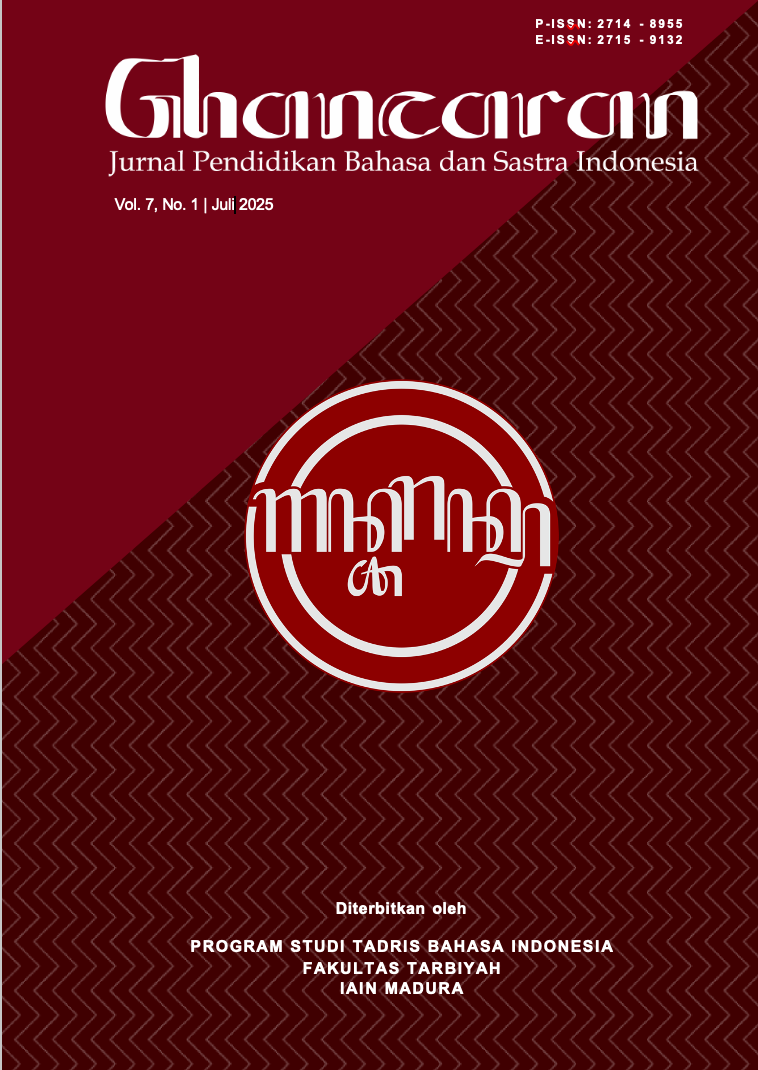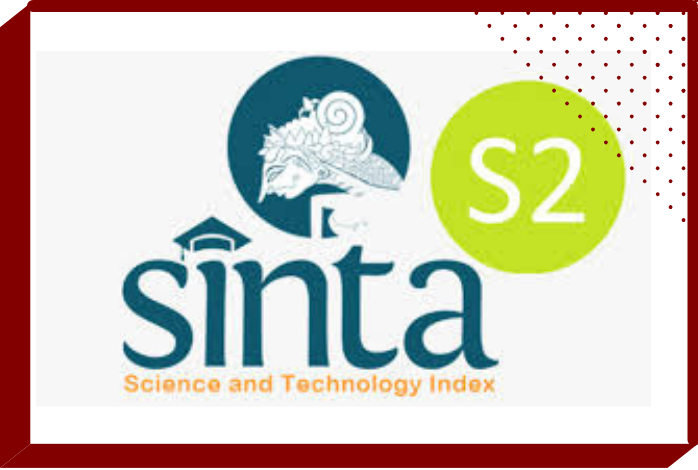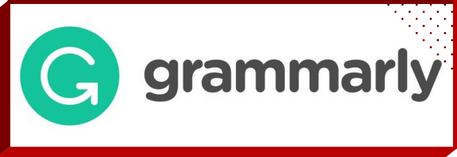Lanskap Linguistik pada Ruang Publik Makam Waliyullah di Madura: Bentuk dan Fungsi Penggunaan Bahasa
 Abstract views: 602
,
Abstract views: 602
,
 PDF downloads: 343
PDF downloads: 343
Abstract
Public spaces in the waliyullah gravesites in Madura are deeply embedded with religious and cultural meanings, as reflected in the use of language on signboards, prayers, and other symbolic representations. This study aims to analyze the forms and functions of language use in the public spaces of waliyullah tombs in Madura. The tombs that serve as the focus of this research include the tomb of Syaikhona Cholil in Bangkalan, the tomb of Ratu Ibu in Sampang, the Batu Ampar tomb in Pamekasan, and the Asta Tinggi tomb in Sumenep. This study employs a qualitative approach with data collection techniques including observation, interviews, and documentation. The findings indicate that Indonesian predominantly dominates language use in the public spaces of waliyullah tombs, while Arabic and Madurese are used to represent religious and local cultural identities. The functions of language in these public spaces include an informative function, which provides guidance and regulations, and a symbolic function, which reinforces religious and cultural identities.
Downloads
References
Akhmad, F. (2020). Walisongo sebagai Fakta Sejarah Islam Nusantara. Al-Munqidz: Jurnal Kajian Keislaman, 8(2), 252-272.
Dersingh, R., Tangkitjaroenkun, T., & Thanarat, P. (2021). Investigating Public Signage in the Border Area of Nong Khai: Multilingualism at a Crossroads. Vacana, 9(2), 130–146.
Efendi, A. N. (2019). Marginalisasi Bahasa: Studi Empiris tentang Visibilitas dan Vitalitas Bahasa di Ruang Publik Kota Surabaya. Prosiding Seminar dan Lokakarya Pengutamaan Bahasa Negara di Ruang Publik: Perkuat Pengawasan, 611-627.
Effendhie, M. (2019). Arsip, Memori, dan Warisan Budaya. Publikasi dan Pameran Arsip.
Ekawati, R., Puspitasari, D., & Ayuningtias, D. I. (2023). The Linguistic Landscape of Religious Tourism Destination in Bangkalan, Madura: Functions and Identity Representation. Jurnal Arbitrer, 10(1), 86-96.
Farcha, I., Ustada, F. H., & Muhajir, M. A. (2023). Persepsi Para Peziarah Makam Walisongo (Studi Kasus di Makam Sunan Kudus). UInScof, 1(1), 489-501.
Gorter, D. (2013). Linguistic Landscapes in a Multilingual World. Annual Review of Applied Linguistics, 33, 190–212.
Gorter, D. (2019). Linguistic Landscapes and the Language Ecology. In Annual Review of Applied Linguistics. De Gruyter Brill.
Gorter, D., & Cenoz, J. (2008). Knowledge about Language and Linguistic Landscape. In N. H. Hornberger (Ed.), Encyclopedia of Language and Education. Boston, MA: Springer.
Jackson, J. (2019). Introducing Language and Intercultural Communication. Routledge.
Kurniawan, B., Hidayah, S. N., & Rahmawati, A. (2024). Pengaruh Penggunaan Bahasa Indonesia terhadap Budaya Lokal pada Masyarakat Madura. Jurnal Media Akademik (JMA), 2(7), 1-8.
Landry, R., & Bourhis, R. Y. (1997). Linguistic Landscape and Ethnolinguistic Vitality: An Empirical Study. Journal of Language and Social Psychology, 16(1), 23–49.
Lutfi, A., Syarifuddin, & Hidayatin, Z. (2023). Peran Bahasa Madura dalam Meningkatkan Kearifan Lokal. Jurnal Lentera Edukasi, 1(2), 7–12.
Miles, M.B. & Huberman, A. M. (2018). Analisis Data Kualitatif. Jakarta: Universitas Indonesia.
Munadifa, S., & Ansori, M. (2024). Bahasa Madura dan Kearifan Lokal: Perspektif dari Desa Kalipang, Kecamatan Grati, Pasuruan. TANDA: Jurnal Kajian Budaya, Bahasa dan Sastra, 4(3), 54–64.
Musman, A. (2021). Walisongo: Sebuah Biografi. Anak Hebat Indonesia.
Peraturan Presiden No. 63 Tahun 2019 tentang Penggunaan Bahasa Indonesia
Putikadyanto, A. P. A., Alatas, M. A., Albaburrahim, A., & Junjunan, M. I. (2024). Multilingualisme dan Kesetiaan Berbahasa Indonesia: Studi Lanskap Linguistik di Ruang Publik Pamekasan, Madura. Ranah: Jurnal Kajian Bahasa, 13(1), 58-70.
Rizaldi, M., & Sulistyo, W. D. (2022). Potensi Wisata Religi Makam Sunan Giri sebagai Wujud Pelestarian Kearifan Lokal Arsitektur Islam di Kabupaten Gresik. Al-Tsaqafa: Jurnal Ilmiah Peradaban Islam, 19(1), 129-136.
Rohman, M. S., & Romadlani, M. M. I. (2023). Lanskap Linguistik Museum di Madura: Studi Kasus Museum Mandhilaras Pamekasan Madura. Journal of Social, Culture, and Language, 2(1), 55-63.
Saputra, M. R. A., Agung, D. A. G., & Efendi, A. N. (2022). Nilai Budaya dan Historis Bangunan Museum Keraton Sumenep sebagai Muatan Karakter Profil Pelajar Pancasila. GHANCARAN: Jurnal Pendidikan Bahasa dan Sastra Indonesia, 14-34.
Sartini, N. W. (2021). Pemetaan Lanskap Linguistik di Universitas Airlangga Surabaya. Kongres Internasional Masyarakat Linguistik Indonesia, 265-268.
Shohamy, E. (2006). Language Policy: Hidden Agendas and New Approaches. New York: Routledge.
Siwina, P., & Prasithrathsint, A. (2020). Multilingual Landscapes on Thailand’s Borders. Journal of Mekong Societies, 16(1), 112–131.
Suprastayasa, I. G. N. A., & Rastitiati, N. K. J. (2023). Warung Makan di Pantai Melasti Bali dalam Kajian Lanskap Linguistik: Dari Tipat Cantok sampai Burger. Jurnal Gastronomi Indonesia, 11(1), 97-104.
Sutrisno, E. P. (2023). Peranan dan Eksistensi Walisongo Terhadap Penyebaran Agama Islam dan Tradisi di Tanah Jawa. Al Bayan Jurnal, 3(1), 51-57.
Undang-Undang No. 24 Tahun 2009 tentang Bendera, Bahasa, dan Lambang Negara serta Lagu Kebangsaan.
Wicaksono, W. A., & Idajati, H. (2020). Identifikasi Karakteristik Objek Daya Tarik Wisata Makam Sunan Bonang Berdasarkan Komponen Wisata Religi. Jurnal Teknik ITS, 8(2), 156-161.
Copyright (c) 2025 GHANCARAN: Jurnal Pendidikan Bahasa dan Sastra Indonesia

This work is licensed under a Creative Commons Attribution-ShareAlike 4.0 International License.
Ghancaran: Jurnal Pendidikan Bahasa dan Sastra Indonesia uses an Open Access Policy under the Creative Commons Attribution-ShareAlike 4.0 International License. Authors publishing in this journal agree to the following terms:
- Ghancaran Journal holds the copyright and grants the journal rights for first publication with the work simultaneously licensed under a

The work is distributed under Creative Commons Attribution-ShareAlike 4.0 International License which allows others to share, copy, and redistribute the material in any media or format and adapt, remix, change, and develop the material even for commercial purposes, as long as it is stated credit and license derivative works under similar terms. - Authors may make additional contractual arrangements for non-exclusive distribution of the journal's published work version.
- Authors are permitted to post their work online (e.g., in institutional repositories or on their websites) before and during submission, as doing so may lead to productive exchange.



















